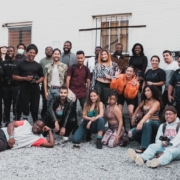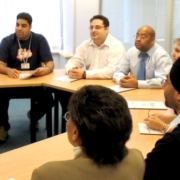By Lila Kelly
Hiring a diverse workforce starts in the recruitment, interview and hiring process, but the work does not stop there. Nor does the responsibility for its success lie with the interviewer, hiring manager or recruiter alone. The likelihood of success with efforts to increase workplace diversity is most likely pre-determined by the organization’s culture, including the values, systems, and common practices of an organization.
Developing organizational cultural competence is key in reaching the organizational goal of achieving a diverse workforce. A good first step is to look beyond the recruiters, interviewers and hiring managers and critically analyze how your organization is doing in its overall cultural competence.
In this article, we will define three stages of organizational cultural competence development, from cultural destructiveness to cultural pre-competence to cultural competence. For each stage on the spectrum, descriptions are offered related to workplace culture, systems and practices.
As you move through each of these stages, ask yourself: Where does my organization stand in its overall cultural competence? How does it exist at the organizational, or system level, and at the individual interviewer or manager level?
Ready? Let’s dive in with Stage One!
Stage One: Cultural Destructiveness
- Cultural diversity is either deliberately ignored or destroyed. This could take place at any point in the recruitment and hiring process. For example, in the recruitment process:
- A resume with a “foreign-sounding” name is thrown away by an HR Recruiter or hiring manager, because the assumption is that the applicant does not speak English well.
- Employee selection practices are unstructured and discriminatory. For example:
- Qualified diverse applicants are systematically eliminated by recruiters and hiring managers.
- Hiring managers intentionally recommend and hire employees who they know and/or who are similar to them.
- Interview question are not necessarily based on the job description nor tied into the performance evaluation for the position for which they are used.
- Members of the organization are either monocultural or highly assimilated “tokens.” For example:
- An employee of a diverse background is hired, perhaps for Affirmative Action / Equal Employment Opportunity (AA/EEO) compliance, and then not provided any guidance, constructive feedback or opportunities to gain new knowledge, skills or promotions.
- Leaders of the organization believe there is only one right way to do things. For example:
- If a diverse employee is hired, he or she is expected to dress, talk, behave, and accomplish their goals in the same manner as all other employees.
Diverse Employees’ Perspectives of Organizational Cultural Destructiveness
Jennie, a Human Resource Director and American Indian, described her struggle trying to motivate the nonprofit organization for which she worked to have more fair and inclusive recruitment, interview and hiring practices.
“Start with internal referrals. It is hard, though, if the company is not very diverse. I am the only Indian at my company. Why aren’t there more Indians? Because their hiring practices are very old fashioned. I feel like I am fighting a losing battle with hiring procedures and applicant tracking. They just hire whomever they wish—their friends and relatives. So other cultures really don’t get an opportunity.
I implemented hiring procedures here as HR Director. Some use them and some don’t. Before there were no hiring procedures, they just hired who they wanted. Half of the personnel records didn’t have applications in them . . . no resumes. They just hired haphazardly, and they didn’t tell anyone when someone was leaving either. It was horrible.”
Rodney, a Computer Department Manager and African American, talked about frustrations he felt when he experienced organizational cultural destructiveness during an interview process.
“The people. . . not being direct. For example, [company name]. . . right after a diversity suit where they got sued for not practicing good hiring practices. . . Certain things that the interviewer said when I posed certain questions to him, how quick the interview was. . . he showed me the area, and there really wasn’t any detailed description of the job I would be doing. I asked about these things, and he beat around the bush and talked about, ‘Well you’ll be doing this, but sometimes you will be doing that. If it was a clear description of what I would be doing, then I could have dealt with the culture. As I read through the interviewer, they just wanted a black face there. Later it was proven because a colleague of mine that went through my graduate program took the job, and he went through hell there, and has left now. They just wanted to say to the legal world that they were practicing fair hiring practices.”
Let’s continue with Stage Two.
Stage Two: Cultural Pre-Competence
- The organization acknowledges that diversity exists, and its intentions are genuine; however, it still operates from a sense that “our way is the best way.” For example:
- Qualified diverse individuals are recruited into the applicant pipeline, but they are not hired for key positions within the organization.
- Staff may be culturally diverse, but still judged by standards of the dominant culture in the organization. For example:
- Employees of diverse backgrounds are hired, but their ideas are not considered.
- Recruitment and hiring are focused on meeting Affirmative Action (AA) and Equal Employment Opportunity (EEO) goals. For example:
- The message from HR is that there is a need for greater effort to diversify the applicant pool. This is translated by a hiring manager to, “We need to hire an African American person.”
- Some attempts are made for diversity recruiting and hiring. For example:
- Attempts to reach out to community organizations for recruiting purposes are made occasionally by a recruiter and/or manager.
- When a recruiter recruits, screens, and passes a qualified diverse applicant on to a hiring manager, the hiring manager may refuse to interview and/or hire that applicant because he or she is from a certain diverse background.
- One or two people on an interview team speak up to hire qualified diverse applicants, but are outnumbered by others with excuses for not hiring them.
- There are attempts at general diversity training for employees, but there is no focus on organizational change. For example:
- Upper management feels that by sending employees through diversity training, they have done enough to address diversity issues in the organization.
- After diversity trainings, there is no follow up on what was learned and no accountability assigned for change.
Diverse Perspectives of Cultural Pre-Competence
Tom, a Vice President of Marketing and Hiring Manager at a corporation and European American, shared his perspective about the recruitment and hiring strategy of an organization at which he previously worked. They were attempting to diversify their workforce and were willing to lower their standards to do so. Since lowering standards is never a wise choice, their attempts were unsuccessful.
“Success was not high with people of color at [my last organization]. We would frankly stretch and be very happy to compromise our standards trying to get people of color to come. For example, if we were recruiting someone who was not from a diverse population, we would use a standard that would say, ‘Are they excellent? Are they premier in terms of building a business?’ When we were trying to get a diverse population, we would probably ask ourselves something like, ‘Do we think they can make it in the system?’ If the answer was yes, then we would do everything possible to try to talk them into coming. But the end result was . . . we never were very successful in building the diversity and maintaining it. They usually moved on to something better.”
Kia, an Attorney and Hmong American, was asked about experiences related to gender either in an interview or the workplace. She replied with this example of a subtle behavior that she felt could make applicants or employees uncomfortable.
“Being female, yes. At work I’ve seen when men are like playing with their. . . shifting their. . . I don’t know how to say this on tape. That type of thing is just totally offensive, and I’ve seen it happen like when guys are doing it in a meeting. I think, ‘Do you even realize what you are doing?’ It is just vulgar. I have a girlfriend who is a partner in a law firm, and she’ll be at her desk, and her partner will come in and put his leg on her desk. So, guess what she is looking at when she looks over to talk with him. It’s a power play over her. When I am in my office – and I am petite – I tell them to sit down. Men especially like to use height as a power adjustment, to be able to look down at someone. I’ll actually tell people, ‘Don’t tower over me at my own desk. Sit down.’”
Let’s conclude now with Stage Three.
Stage Three: Cultural Competence
- The organization values diversity, and its leaders view it as an asset, not a problem.
- The organization has a clearly defined business case for diversity, and it follows a strategic diversity and inclusion action plan based on an organizational needs assessment.
- Diversity is integrated into the system rather than established as a separate program, job position or department. For example:
- Diversity is integrated into all business strategies and included in all business and management decisions.
- All interviewers and managers are trained on personal and organizational dynamics of racism, sexism, ableism, ageism, homophobia, gender identity, Islamophobia, etc.
- A zero-tolerance policy for any type of harassment or inappropriate behavior is in place and enforced throughout the organization. This policy is in writing, all employees are aware of it, and swift action is taken to enforce it.
- The organization maintains high rates of recruitment and hiring of diverse applicants. For example:
- The organization’s name is well branded in diverse communities.
- Strategic recruitment is conducted year-round to maintain a diverse applicant pool.
- Interview questions are inclusive and tied to job descriptions and performance evaluations.
- Recruitment, interviewing, and hiring practices are structured and consistent across the organization, and able to withstand push back for diversity efforts.
- All interviewers and hiring managers are trained to be culturally-competent at interviewing.
- Interviewers understand that each applicant is unique, can recognize and manage their biases, and do not make assumptions based on appearance.
- Each interview and hiring team member is willing to act affirmatively to hire qualified diverse applicants.
- The organization maintains high satisfaction and retention rates of employees and customers. For example:
- HR’s diversity-related policies and procedures are followed and enforced, without backlash for employees of diverse backgrounds, having a positive effect on morale, retention and future recruiting of diverse employees.
- High satisfaction rates are maintained among diverse and non-diverse employees, as well as customers and communities served.
Diverse Perspectives of Cultural Competence and Cultural Proficiency
Tyrone, an HR Director and African American, offered this insight for a culturally-competent organization.
“Talk to me about how you are attracting people of widely different skills, backgrounds. Don’t call it diversity, call it business strategy. I’m moving away from naming conventions that tend to restrict more than they expand. The word ‘diversity,’ five or ten years ago, people thought that was a replacement for Affirmative Action. And it was more color, race and sex based than we know it as today. So, talk to me about business strategy, what sort of human resources do you need to get the job done, and what are you doing to attract those. That’s diversity, and it’s a business strategy.”
Sena, a Community Organizer and Latina, shared this insight about cultural competence related to an employer perceiving a situation, without making incorrect assumptions based on an employee’s race or gender.
“We all come from such different backgrounds, and what motivates employee ‘A’ may not motivate employee ‘B.’ This can be true of Anglo culture also. In some cultures, family is important, and if an employer understands that, then when the mom calls in because her child is sick, it’s not that she thinks any less of her job, but her children come first. I think this is all people, not just people of color.”
Rick, a European American HR Director at a manufacturing company, was very clear about whose responsibility it is to make diverse employees feel welcomed and fit into the work environment.
“The customer service manager said to me, ‘You know, these salesmen, they make a lot of racial comments.’ At the time we were considering a person of color, and she was afraid that this person would be exposed to that. My comment to her was, ‘Who’s got the problem? Is that her problem or is that our problem?’ I told her, ‘That’s our problem,’ or it’s the corporate office’s problem. Whatever, we should not deny her an employment opportunity because the salespeople make racial jokes. They have to change their behavior.”
Integrating diversity, equity and inclusion (DEI) into the organization beyond employee selection will affect employee retention, customer relations, and future diversity recruitment and hiring efforts. This spectrum can be used as a tool to determine an organization’s phase of cultural competence development and help the organization understand where they still need to go in order to achieve their diversity and inclusion goals.
— Copyright © 2022 Lila Kelly Associates, LLC. Not to be reprinted without written permission from Lila Kelly. Integrating Diversity into Hiring, Interviewing, Recruiting and Retention – Since 1992. This article includes excerpts from Lila Kelly’s online training and books at diversityintegration.com. To stay up to date on all the latest from Lila Kelly Associates LLC & DiversityIntegration.com subscribe to our newsletter.









